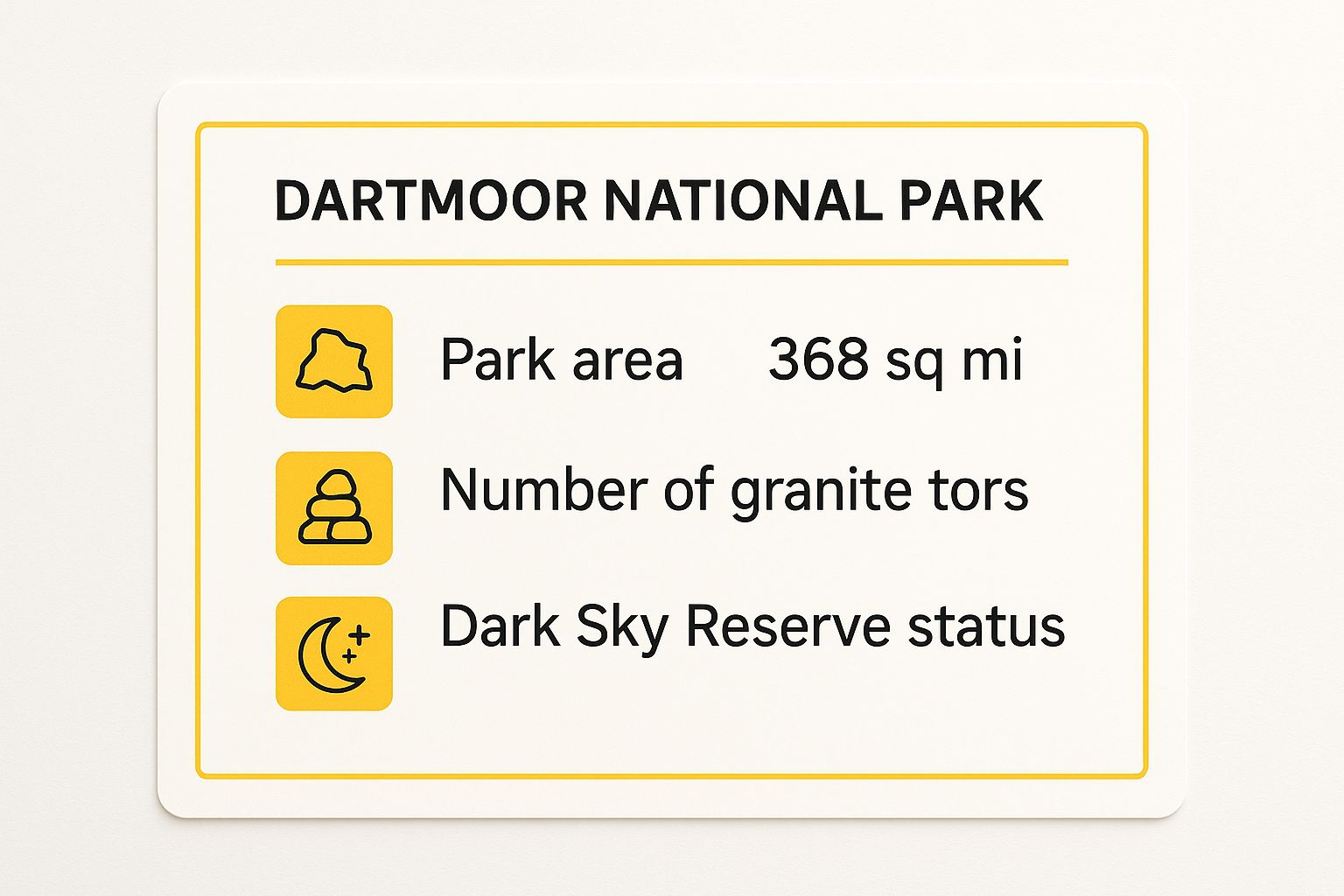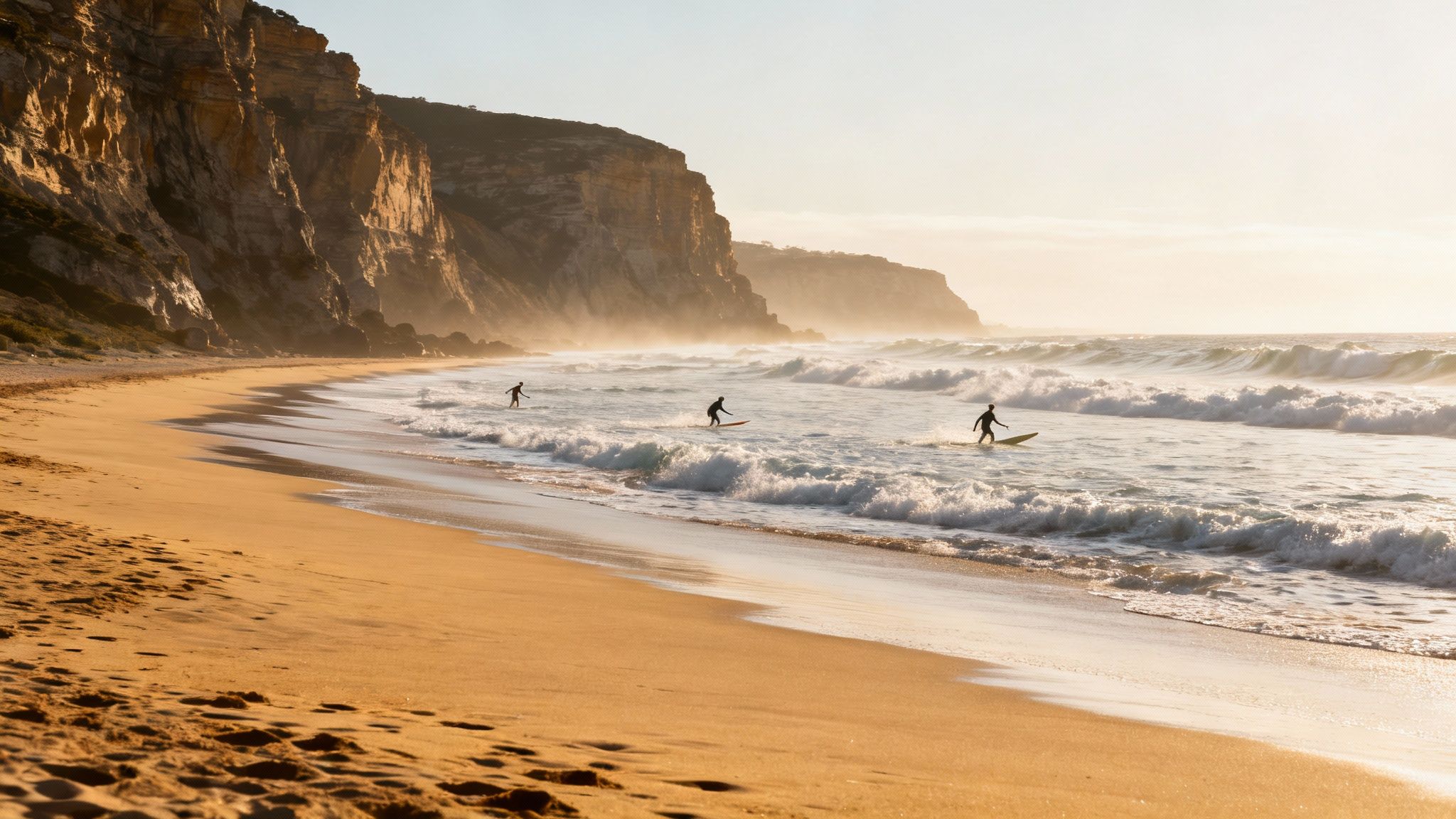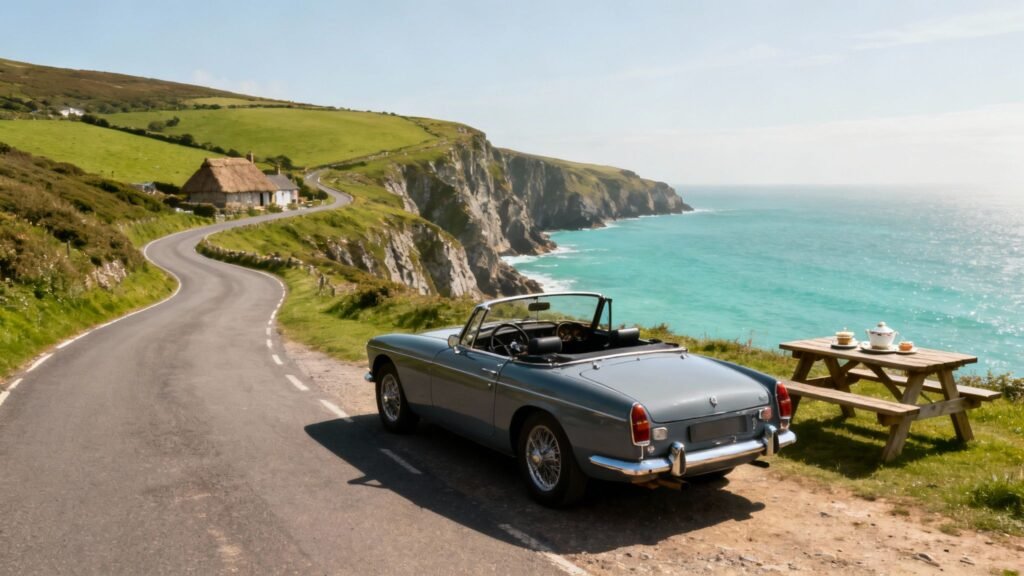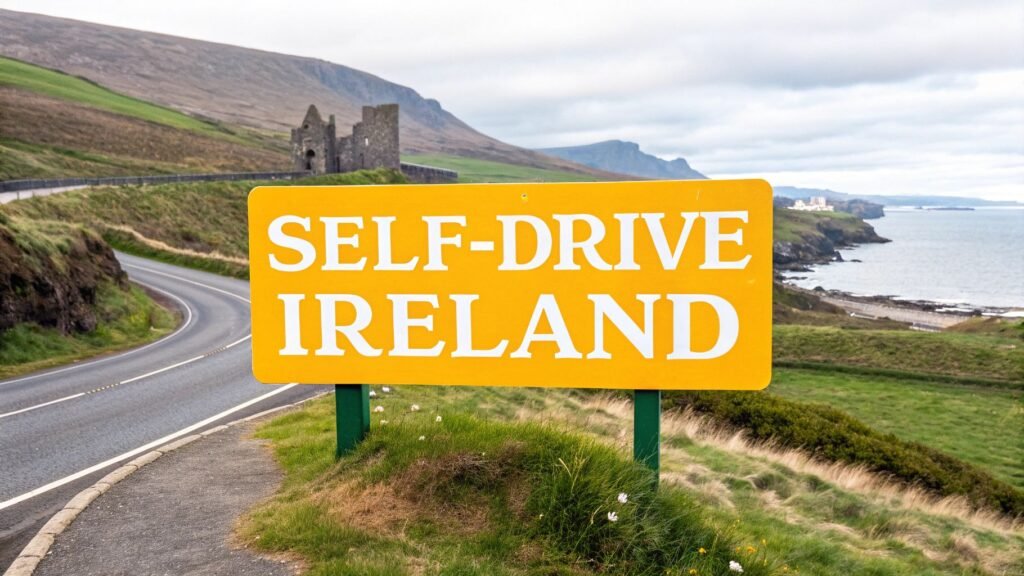Welcome to Devon, a county where dramatic coastlines meet wild moorlands and history whispers from ancient cathedral cities. For the self-drive traveller, this region offers an unparalleled sense of freedom and discovery. Forget rigid tour schedules and crowded buses; this guide is your key to unlocking the liberty of the open road, from the fossil-rich shores of the Jurassic Coast to the surf-perfect waves of the north. We've curated this definitive list to highlight the best places in Devon, blending iconic landmarks like Exeter Cathedral with hidden gems that only a car journey can truly reveal.
This is more than just a simple list; it's a practical roadmap designed specifically for those behind the wheel. We focus on actionable insights for independent exploration, covering everything from navigating the narrow lanes of a thatched-roof village to finding the perfect spot for a spontaneous cream tea with a panoramic view. You're in complete control of your adventure. Each destination has been selected to showcase the diverse beauty and character of Devon, ensuring your road trip is packed with memorable experiences. Whether you are a nature aficionado, a history enthusiast, or a family seeking adventure, this guide provides the essential details for your journey. Let's start the engine and explore what makes Devon unforgettable.
1. Dartmoor National Park
Dartmoor National Park is an ancient and atmospheric landscape that truly defines the wild heart of Devon. Spanning 368 square miles, its rugged beauty has captivated artists and adventurers for centuries. This sprawling moorland is punctuated by dramatic granite tors, mysterious prehistoric settlements, and deep, wooded valleys, making it one of the most compelling places to visit in Devon. The park offers a profound sense of freedom and a direct connection to a history stretching back to the Bronze Age.
Its literary and cinematic fame, popularised by Sir Arthur Conan Doyle's The Hound of the Baskervilles and Steven Spielberg's War Horse, only adds to its allure. Visitors can climb the iconic Haytor Rocks for panoramic views, wander through the gnarled, moss-covered trees of the ancient Wistman's Wood, or explore the remarkably preserved remains of Grimspound, a Bronze Age settlement.
Planning Your Dartmoor Visit
To make the most of your trip, preparation is key, as the weather can change in an instant and mobile phone signal is often non-existent.
- Be Prepared: Always check the weather forecast and pack waterproofs and layers. Sturdy walking boots are essential.
- Navigation: Download offline maps or carry a physical map and compass. Don't rely solely on your phone.
- Timing: Visit popular spots like Haytor early in the morning or on weekdays to avoid the largest crowds.
- Respect the Code: The 'Dartmoor Code' is vital for conservation. Always close gates, keep dogs under control, and take all your litter home with you.
The infographic below summarises a few key facts about this unique national park.

These figures highlight not just the park's vast scale but also its unique geological and astronomical significance.
2. Exeter Cathedral and Historic City
Exeter stands as Devon's historic capital, a city where 2,000 years of history are etched into its very fabric. At its heart lies the magnificent Exeter Cathedral, a Gothic masterpiece that is undoubtedly one of the best places in Devon for architecture and heritage enthusiasts. The city effortlessly blends its Roman and medieval past with a vibrant, modern atmosphere of shopping, dining, and culture, offering a rich experience for every visitor. The cathedral itself, completed around 1400, is famed for possessing the longest uninterrupted stretch of medieval Gothic vaulting in the world.
The city's cultural significance extends beyond its ancient walls, having inspired literary figures like Thomas Hardy and hosted future stars such as J.K. Rowling and Coldplay's Chris Martin during their university years. Visitors can delve into medieval history by touring the unique Underground Passages, enjoy the regenerated Exeter Quay with its award-winning restaurants, or explore nearby stately homes like Powderham Castle, a filming location for The Remains of the Day.
Planning Your Exeter Visit
To truly appreciate Exeter's blend of old and new, a little planning goes a long way, especially when navigating the city centre.
- Book in Advance: Tours for the popular Underground Passages often sell out, especially during peak seasons. Book your tickets online beforehand to avoid disappointment.
- Smart Parking: Exeter’s city centre parking can be expensive and limited. Utilise the excellent Park and Ride services for a stress-free and cost-effective way to get into the heart of the city.
- Free Guided Tours: Take advantage of the free Red Coat Guided Tours to gain fascinating insights into the city's long history. The guides are volunteers, and tips are greatly appreciated.
- Cultural Timing: To avoid the busiest times, plan your visit to the award-winning Royal Albert Memorial Museum (RAMM) on a weekday.
Exploring Exeter provides a fantastic experience, making it an ideal destination for those interested in rich historical narratives. For more inspiration on urban adventures, you can explore our guide to city breaks.
3. Jurassic Coast (East Devon)
Devon's portion of the Jurassic Coast is a globally significant UNESCO World Heritage Site, offering a stunning journey through 185 million years of Earth's history. This 95-mile coastline begins in East Devon, where dramatic, rust-red Triassic cliffs dominate the landscape. It is a geological marvel, revealing ancient deserts and prehistoric life, making it one of the most educational and best places in Devon for curious travellers and families.

The area's importance has been highlighted in documentaries by naturalists like Sir David Attenborough and is intrinsically linked to the pioneering work of fossil hunter Mary Anning in nearby Lyme Regis. Visitors can marvel at the iconic sea stacks of Ladram Bay, explore the charming fishing village of Beer, or walk along the vast shingle expanse of Branscombe Beach. The journey officially begins at Orcombe Point in Exmouth, where a geoneedle marks the start of this incredible walk through time.
Planning Your Jurassic Coast Visit
A safe and rewarding trip to this dynamic coastline requires attention to tides, weather, and the natural environment.
- Safety First: Never climb on or stand directly beneath the cliffs. Rockfalls are a constant and serious risk.
- Check the Tides: Always check tide times before heading out to explore beaches to avoid being cut off.
- Fossil Hunting: The best time to find fossils is after winter storms have exposed new layers. Wear sturdy footwear for walking on uneven, shingly beaches.
- Respect the Environment: Follow the Countryside Code. Appreciate the geology from a safe distance and leave no trace of your visit. Take binoculars to spot the rich birdlife.
4. Salcombe and South Hams
Salcombe and the surrounding South Hams district represent the quintessential English coastal dream. This upscale waterfront town, nestled in a stunning natural harbour, boasts a unique microclimate that allows palm trees to thrive along its estuary. Known for its crystal-clear waters and pristine sandy beaches, Salcombe offers a slice of Mediterranean charm in the heart of South Devon, making it one of the best places in Devon for a seaside escape.
The area's reputation for luxury and natural beauty is well-earned. Visitors can explore the bustling Salcombe Harbour, home to an annual regatta, or take a foot ferry to the Blue Flag beach at South Sands. For a dose of culture, the National Trust’s Overbeck's Museum and Garden showcases subtropical plants with breathtaking coastal views. This blend of sophisticated town life and idyllic scenery is further enhanced by its association with the award-winning Salcombe Gin Company and its popularity as a holiday spot for high-profile visitors.
Planning Your Salcombe Visit
To navigate this popular destination smoothly, especially during peak season, a little planning goes a long way. The narrow streets can become congested, so using local services is highly recommended.
- Parking Smart: Use the park-and-ride service during busy summer months to avoid the stress of finding a space in the town centre.
- Book Ahead: Ferries to beaches like South Sands and dinner reservations at sought-after restaurants should be booked well in advance.
- Explore on Water: Rent a kayak or paddleboard to discover secluded coves and hidden beaches that are inaccessible by foot.
- Timing is Everything: Visit in the shoulder seasons (May-June or September) for fewer crowds, better value, and pleasant weather.
The beauty of this region is a highlight on many tours of the UK's southern coast. To see how Salcombe fits into a broader journey, you can explore a Taste of South England and Wales itinerary.
5. Woolacombe Beach and North Devon Coast
Woolacombe Beach is a spectacular three-mile stretch of golden sand that consistently ranks among Britain's best beaches, making it one of the most unmissable places in Devon. Located on North Devon's dramatic Atlantic coast, its pristine shoreline and powerful waves offer world-class surfing conditions, while the vast expanse of sand provides ample space for families and sun-seekers. This classic seaside destination is a perfect blend of natural beauty and vibrant coastal energy.

Its award-winning status, celebrated by TripAdvisor and the British Surfing Association, draws visitors year-round. Beyond the main beach, you can explore the rugged coastal path to Morte Point, known for its dramatic shipwreck history, or visit nearby Croyde Bay, another surfing hotspot. For a change of pace, the Victorian seaside town of Ilfracombe, home to Damien Hirst’s striking 'Verity' sculpture, is just a short drive away.
Planning Your Woolacombe Visit
To get the most out of your coastal adventure, a little forward planning goes a long way, especially during the busy summer months.
- Parking & Crowds: Arrive before 10 am or after 3 pm for easier parking. For a quieter spot, walk north towards Putsborough or south to Barricane Beach for excellent shell collecting.
- Safety First: The Atlantic swell can be powerful. Always swim between the red and yellow flags where RNLI lifeguards are on patrol.
- Be Prepared: The coastal breeze can be strong, so a windbreak is a very useful addition to your beach kit.
- Activities: Book surf lessons in advance during peak season. At low tide, the rockpools at the southern end of the beach are fantastic for exploring with children.
6. Totnes and the River Dart
Totnes is a captivating historic market town nestled on the banks of the River Dart, famed for its fiercely independent spirit and bohemian culture. As one of England’s oldest boroughs, its story is etched into the steep main street, lined with Tudor and Elizabethan buildings that now house a vibrant array of unique shops, art galleries, and wholefood cafes. The town is crowned by a classic Norman motte-and-bailey castle, offering panoramic views over the town and the winding river valley.
Its reputation as a pioneer of ethical and sustainable living is well-earned; Totnes was the birthplace of the global Transition Towns movement, a grassroots response to climate change. This ethos is visible everywhere, from zero-waste shops to community-led initiatives. Visitors can wander through the ancient Narrows, climb the castle keep for stunning vistas, or explore the legacy of local figures like Agatha Christie, whose holiday home, Greenway, is a short, scenic boat trip down the river.
Planning Your Totnes Visit
To truly appreciate Totnes, immerse yourself in its alternative culture and riverside beauty. It’s one of the best places in Devon to explore on foot and by water.
- Best Times to Visit: Arrive on a Friday or Saturday to experience the lively market days, when the town buzzes with local producers and artisans.
- River Travel: The most scenic way to arrive or depart is by boat. The river cruise between Totnes and Dartmouth offers breathtaking views of ancient woodlands and secluded creeks.
- Explore Independents: Dedicate time to browsing the independent bookshops, such as the renowned Totnes Bookshop, and the numerous quirky retailers that give the town its unique character.
- Local Flavours: Don't miss a visit to the Sharpham Estate for a wine and cheese tasting, accessible via a beautiful riverside walk from the town centre. For those interested in sustainable food, Riverford Organic Farmers, pioneers of the vegetable box scheme, is nearby. A self-drive tour is an ideal way to explore these unique local producers. You can find out more about itineraries that include these culinary highlights on a Taste of England self-drive tour.
7. Croyde and Saunton Sands
Croyde and Saunton Sands form the epicentre of North Devon's vibrant surf culture, offering two distinct but equally stunning coastal experiences. Croyde is a quintessential surf village, filled with charming thatched cottages and a world-class beach break that hosts national surf championships. Its compact, powerful waves make it a magnet for experienced surfers, creating an energetic and laid-back atmosphere that defines the area as one of the best places in Devon for beach lovers.
Just around the headland lies Saunton Sands, a magnificent three-mile stretch of golden sand backed by Braunton Burrows, a UNESCO Biosphere Reserve. Saunton’s gentler, rolling waves are perfect for beginners and longboarders, while its sheer scale ensures you can always find a quiet spot. The beach's cinematic beauty has made it a popular filming location, featured in everything from Pink Floyd's The Wall to the film Aquaman and the Lost Kingdom.
Planning Your Croyde and Saunton Visit
To fully enjoy this iconic stretch of coastline, a little local knowledge goes a long way, especially during peak season when parking can be challenging.
- Surf Smart: Check the tide times and surf forecast before you go. Book lessons for early morning slots to avoid the biggest crowds, and always respect local surf etiquette in the water.
- Parking Strategy: Parking in Croyde village is limited. A great alternative is to park at Saunton Sands and take the scenic coastal path over the headland to Croyde.
- Explore Braunton Burrows: These historic dunes, used for D-Day landing practice in WWII, offer fantastic walks with unique flora and fauna.
- Dress Appropriately: The North Atlantic water is cold year-round. A full wetsuit is recommended, even in the height of summer, to stay comfortable.
8. Dartmouth and Kingswear
Nestled on the banks of the River Dart estuary, Dartmouth and its neighbouring village Kingswear offer a captivating blend of maritime heritage, stunning scenery, and architectural charm. Dartmouth is famed for its deep-water natural harbour and its centuries-long association with the Royal Navy, which gives the town a prestigious and historic atmosphere. This bustling waterfront town, with its narrow streets, medieval buildings, and thriving food scene, is easily one of the best places in Devon for those who love the water.
The area’s appeal is broadened by its cultural connections, most notably with the crime novelist Agatha Christie, whose beloved holiday home, Greenway, is a short ferry ride upriver. Visitors can explore the historic Dartmouth Castle guarding the estuary mouth, enjoy a trip on the Dartmouth Steam Railway from Kingswear, or indulge in the fresh seafood celebrated at the annual Dartmouth Food Festival. The combination of river life, history, and coastal beauty makes for an unforgettable visit.
Planning Your Dartmouth and Kingswear Visit
To navigate the steep hills and often-congested streets, a little forward planning will greatly enhance your experience.
- Parking: Use the park-and-ride service located on the edge of Dartmouth, as town centre parking is extremely limited and challenging to find.
- Getting Across: The higher ferry is for vehicles, while the lower passenger ferry offers a quicker foot crossing between Dartmouth and Kingswear.
- Book Ahead: Restaurants and boat trips get very busy, especially during the summer and the famous Royal Regatta. Always book in advance to avoid disappointment.
- Footwear: Be prepared for steep hills. Comfortable walking shoes are essential for exploring the town and its beautiful coastal paths, such as the walk to Dartmouth Castle.
9. Clovelly Village
Clovelly Village is an impossibly picturesque fishing hamlet, clinging to a 400-foot cliff on the dramatic North Devon coast. This privately-owned village is a perfectly preserved time capsule where life moves at a different pace. Its most defining feature is the steep, cobbled high street, which tumbles down to the ancient harbour, and is famously free of all vehicular traffic. Instead, goods and luggage are transported on traditional wooden sledges, a practice that continues to this day.
The village's timeless charm, with its flower-decked, whitewashed cottages, has made it a popular filming location for period dramas and an inspiration for writers like Charles Kingsley, who lived here as a child. A visit to Clovelly is not just a sightseeing trip; it’s an immersive step back into a simpler, more rugged era of maritime life, making it one of the most unique and best places in Devon to explore.
Planning Your Clovelly Visit
The village's unique geography requires some practical planning to ensure a comfortable and enjoyable experience.
- Footwear is Key: The steep, historic cobbles are uneven and can be slippery. Sturdy, comfortable, non-slip shoes are absolutely essential.
- Time Your Visit: Arrive early in the morning or later in the afternoon to miss the peak crowds from coach tours, allowing for a more atmospheric walk.
- The Return Journey: The walk back up is very steep. A Land Rover service is available to transport visitors from the harbour to the visitor centre at the top (a fee may apply).
- Capture the Moment: Every corner of Clovelly is incredibly photogenic, from the donkeys to the harbour walls, so be sure to bring your camera.
10. Lynton and Lynmouth (Valley of Rocks)
Nestled on the dramatic North Devon coast where Exmoor National Park meets the sea, the twin Victorian towns of Lynton and Lynmouth offer a truly unique experience. Known affectionately as ‘Little Switzerland’ since the 19th century, this area combines breathtaking coastal cliffs, a deep wooded gorge, and a captivating, almost otherworldly, landscape. The two towns, one perched high on the cliff and the other nestled by the harbour, are linked by a famous and ingenious water-powered cliff railway.
The area’s romantic scenery has long inspired poets like Shelley and Coleridge, and its literary heritage is cemented by its feature in R.D. Blackmore’s classic novel Lorna Doone. Beyond the towns lies the magnificent Valley of Rocks, a dry valley with towering rock formations and a resident herd of feral goats. Visitors can wander through this surreal landscape, explore the stunning grounds of Watersmeet House, or simply enjoy the timeless charm of these perfectly preserved coastal settlements, making it one of the best places in Devon for scenery and history.
Planning Your Lynton and Lynmouth Visit
To get the most out of these enchanting towns and their wild surroundings, a little planning goes a long way.
- Ride the Railway: Take the Lynton and Lynmouth Cliff Railway both ways. The journey up offers a different perspective of the harbour and coastline than the one down.
- Early Morning Walk: For the best chance to see the famous wild goats and avoid the crowds, walk the coastal path through the Valley of Rocks early in the morning.
- Respect the Elements: The weather on this exposed coastline can change rapidly. Always bring layers and waterproofs, even on a sunny day.
- Book Ahead: During peak season, booking tickets for the cliff railway online can help you avoid lengthy queues.
Top 10 Devon Destinations Comparison
| Location | Implementation Complexity | Resource Requirements | Expected Outcomes | Ideal Use Cases | Key Advantages |
|---|---|---|---|---|---|
| Dartmoor National Park | Moderate – requires navigation skills and preparation | Minimal cost, basic outdoor gear needed | Wilderness exploration, hiking, cultural history | Outdoor activities, nature lovers, stargazers | Free access, rich history, dark skies |
| Exeter Cathedral and Historic City | Low – easy urban access | Moderate – transport, accommodation | Cultural exploration, historic sightseeing | City breaks, cultural tourism | Excellent transport, rich culture |
| Jurassic Coast (East Devon) | Moderate – varied terrain safety caution | Basic footwear and geology guides | Geological study, fossil hunting, coastal walks | Education, coastal walks, fossil hunting | UNESCO site, free access, unique geology |
| Salcombe and South Hams | Moderate – booking advised, pricey | High – accommodation and dining costs | Luxury coastal experiences, sailing, fine dining | Luxury holidays, sailing, food enthusiasts | Mild climate, premium facilities |
| Woolacombe Beach and North Devon Coast | Low-Moderate – good facilities but weather variable | Moderate – surf gear, accommodation | Surfing, family beach days, nature walks | Surfing, families, beach holidays | Award-winning beach, good accessibility |
| Totnes and the River Dart | Low – town exploration and river trips | Low-Moderate – local transport, dining | Cultural engagement, eco-tourism, markets | Alternative culture seekers, history buffs | Strong community, river trips, independent shops |
| Croyde and Saunton Sands | Moderate – surf conditions and parking issues | Moderate – surf gear, early booking | Surfing, nature appreciation, beach lifestyle | Surfers, outdoor enthusiasts | World-class surf, natural dunes |
| Dartmouth and Kingswear | Moderate – hilly terrain, transport coordination | Moderate – accommodation, ferry costs | Maritime history, river cruises, festivals | History and food lovers, photographers | Deep harbor, rich heritage, good food scene |
| Clovelly Village | Moderate – steep terrain, entrance fee | Low-Moderate – ticket and local services | Historical village experience, photography | History enthusiasts, unique cultural visits | Unique car-free village, authentic setting |
| Lynton and Lynmouth (Valley of Rocks) | Moderate – steep terrain, limited transport | Moderate – some transport and accommodation | Dramatic scenery, walking, literary interest | Walkers, romantic getaways, literature fans | Cliff railway, dramatic landscapes |
Crafting Your Perfect Devon Itinerary
From the wild, heather-clad tors of Dartmoor to the fossil-rich cliffs of the Jurassic Coast, our journey through Devon has revealed a county of incredible diversity and profound beauty. We have wandered through ancient cathedral cities, explored impossibly quaint fishing villages, and relaxed on some of the UK’s most celebrated beaches. Each destination offers a distinct flavour of this West Country gem, proving that the best places in Devon are as varied as they are captivating.
The true magic of exploring Devon, however, lies in the freedom to connect these unique experiences into a personal adventure. A self-drive tour is the perfect way to embrace this spontaneity, allowing you to craft a journey that reflects your own interests and pace.
Blending Your Devon Experiences
The key to a truly memorable trip is to weave together the different threads of Devon's character. Imagine a day that starts with a brisk coastal walk along the dramatic cliffs near Lynton and Lynmouth, followed by a leisurely pub lunch in a historic inn. In the afternoon, you could find yourself stepping back in time within the magnificent walls of Exeter Cathedral, before ending your day with a seafood dinner overlooking Salcombe’s sparkling estuary. This ability to blend rugged nature, rich history, and coastal charm is what makes a road trip here so special.
Practical Steps for Your Devon Road Trip
To turn this inspiration into reality, consider these actionable steps:
- Group by Geography: Plan your route by region to minimise driving time and maximise exploration. For instance, combine North Devon's coastal wonders like Woolacombe, Croyde, and Clovelly into one segment, and focus on South Hams destinations like Salcombe and Dartmouth in another.
- Mix Your Activities: Consciously plan for variety. Pair a physically active day, like hiking on Dartmoor or surfing at Saunton Sands, with a more relaxed day exploring cultural sites like Dartmouth Castle or the independent shops of Totnes.
- Embrace Flexibility: While a plan is essential, leave room for spontaneous discoveries. That hidden cove you spot from the road or the charming village tearoom you stumble upon are often the most cherished memories of any road trip.
By thoughtfully combining the destinations we've explored, you move beyond simply visiting a list of places and begin to craft a cohesive, personal narrative. You are no longer just a tourist; you are an explorer, curating an itinerary that captures the very essence of what makes this county unforgettable. The freedom of the open road empowers you to discover not just the well-trodden paths, but also the quiet corners that define the soul of Devon. This is how you find your best places in Devon.
Ready to experience Devon's stunning landscapes without the stress of planning? At BTOURS, we specialise in crafting seamless self-drive itineraries that cover all the highlights and hidden gems. Let us handle the route planning and accommodation, so you can focus on making unforgettable memories. Explore our curated England self-drive tours and start designing your perfect Devon adventure today.



